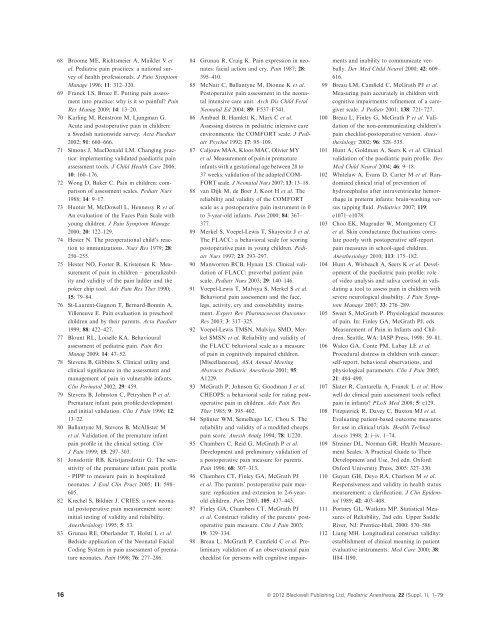Good Practice in Postoperative and Procedural Pain Management ...
Good Practice in Postoperative and Procedural Pain Management ...
Good Practice in Postoperative and Procedural Pain Management ...
Create successful ePaper yourself
Turn your PDF publications into a flip-book with our unique Google optimized e-Paper software.
68 Broome ME, Richtsmeier A, Maikler V etal. Pediatric pa<strong>in</strong> practices: a national surveyof health professionals. J Pa<strong>in</strong> SymptomManage 1996; 11: 312–320.69 Franck LS, Bruce E. Putt<strong>in</strong>g pa<strong>in</strong> assessment<strong>in</strong>to practice: why is it so pa<strong>in</strong>ful? Pa<strong>in</strong>Res Manag 2009; 14: 13–20.70 Karl<strong>in</strong>g M, Renstrom M, Ljungman G.Acute <strong>and</strong> postoperative pa<strong>in</strong> <strong>in</strong> children:a Swedish nationwide survey. Acta Paediatr2002; 91: 660–666.71 Simons J, MacDonald LM. Chang<strong>in</strong>g practice:implement<strong>in</strong>g validated paediatric pa<strong>in</strong>assessment tools. J Child Health Care 2006;10: 160–176.72 Wong D, Baker C. Pa<strong>in</strong> <strong>in</strong> children: comparisonof assessment scales. Pediatr Nurs1988; 14: 9–17.73 Hunter M, McDowell L, Hennessy R et al.An evaluation of the Faces Pa<strong>in</strong> Scale withyoung children. J Pa<strong>in</strong> Symptom Manage2000; 20: 122–129.74 Hester N. The preoperational child’s reactionto immunizations. Nurs Res 1979; 28:250–255.75 Hester NO, Foster R, Kristensen K. Measurementof pa<strong>in</strong> <strong>in</strong> children – generalizability<strong>and</strong> validity of the pa<strong>in</strong> ladder <strong>and</strong> thepoker chip tool. Adv Pa<strong>in</strong> Res Ther 1990;15: 79–84.76 St-Laurent-Gagnon T, Bernard-Bonn<strong>in</strong> A,Villeneuve E. Pa<strong>in</strong> evaluation <strong>in</strong> preschoolchildren <strong>and</strong> by their parents. Acta Paediatr1999; 88: 422–427.77 Blount RL, Loiselle KA. Behaviouralassessment of pediatric pa<strong>in</strong>. Pa<strong>in</strong> ResManag 2009; 14: 47–52.78 Stevens B, Gibb<strong>in</strong>s S. Cl<strong>in</strong>ical utility <strong>and</strong>cl<strong>in</strong>ical significance <strong>in</strong> the assessment <strong>and</strong>management of pa<strong>in</strong> <strong>in</strong> vulnerable <strong>in</strong>fants.Cl<strong>in</strong> Per<strong>in</strong>atol 2002; 29: 459.79 Stevens B, Johnston C, Petryshen P et al.Premature <strong>in</strong>fant pa<strong>in</strong> profile:development<strong>and</strong> <strong>in</strong>itial validation. Cl<strong>in</strong> J Pa<strong>in</strong> 1996; 12:13–22.80 Ballantyne M, Stevens B, McAllister Met al. Validation of the premature <strong>in</strong>fantpa<strong>in</strong> profile <strong>in</strong> the cl<strong>in</strong>ical sett<strong>in</strong>g. Cl<strong>in</strong>J Pa<strong>in</strong> 1999; 15: 297–303.81 Jonsdottir RB, Kristjansdottir G. The sensitivityof the premature <strong>in</strong>fant pa<strong>in</strong> profile- PIPP to measure pa<strong>in</strong> <strong>in</strong> hospitalizedneonates. J Eval Cl<strong>in</strong> Pract 2005; 11: 598–605.82 Krechel S, Bildner J. CRIES: a new neonatalpostoperative pa<strong>in</strong> measurement score:<strong>in</strong>itial test<strong>in</strong>g of validity <strong>and</strong> relaibility.Anesthesiology 1995; 5: 53.83 Grunau RE, Oberl<strong>and</strong>er T, Holsti L et al.Bedside application of the Neonatal FacialCod<strong>in</strong>g System <strong>in</strong> pa<strong>in</strong> assessment of prematureneonates. Pa<strong>in</strong> 1998; 76: 277–286.84 Grunau R, Craig K. Pa<strong>in</strong> expression <strong>in</strong> neonates:facial action <strong>and</strong> cry. Pa<strong>in</strong> 1987; 28:395–410.85 McNair C, Ballantyne M, Dionne K et al.<strong>Postoperative</strong> pa<strong>in</strong> assessment <strong>in</strong> the neonatal<strong>in</strong>tensive care unit. Arch Dis Child FetalNeonatal Ed 2004; 89: F537–F541.86 Ambuel B, Hamlett K, Marx C et al.Assess<strong>in</strong>g distress <strong>in</strong> pediatric <strong>in</strong>tensive careenvironments: the COMFORT scale. J PediatrPsychol 1992; 17: 95–109.87 Caljouw MAA, Kloos MAC, Olivier MYet al. Measurement of pa<strong>in</strong> <strong>in</strong> premature<strong>in</strong>fants with a gestational age between 28 to37 weeks: validation of the adapted COM-FORT scale. J Neonatal Nurs 2007; 13: 13–18.88 van Dijk M, de Boer J, Koot H et al. Thereliability <strong>and</strong> validity of the COMFORTscale as a postoperative pa<strong>in</strong> <strong>in</strong>strument <strong>in</strong> 0to 3-year-old <strong>in</strong>fants. Pa<strong>in</strong> 2000; 84: 367–377.89 Merkel S, Voepel-Lewis T, Shayevitz J et al.The FLACC: a behavioral scale for scor<strong>in</strong>gpostoperative pa<strong>in</strong> <strong>in</strong> young children. PediatrNurs 1997; 23: 293–297.90 Manworren RCB, Hynan LS. Cl<strong>in</strong>ical validationof FLACC: preverbal patient pa<strong>in</strong>scale. Pediatr Nurs 2003; 29: 140–146.91 Voepel-Lewis T, Malviya S, Merkel S et al.Behavioral pa<strong>in</strong> assessment <strong>and</strong> the face,legs, activity, cry <strong>and</strong> consolability <strong>in</strong>strument.Expert Rev Pharmacoecon OutcomesRes 2003; 3: 317–325.92 Voepel-Lewis TMSN, Malviya SMD, MerkelSMSN et al. Reliability <strong>and</strong> validity ofthe FLACC behavioral scale as a measureof pa<strong>in</strong> <strong>in</strong> cognitively impaired children.[Miscellaneous]. ASA Annual Meet<strong>in</strong>gAbstracts Pediatric Anesthesia 2001; 95:A1229.93 McGrath P, Johnson G, <strong>Good</strong>man J et al.CHEOPS: a behavioral scale for rat<strong>in</strong>g postoperativepa<strong>in</strong> <strong>in</strong> children. Adv Pa<strong>in</strong> ResTher 1985; 9: 395–402.94 Spl<strong>in</strong>ter WM, Semelhago LC, Chou S. Thereliability <strong>and</strong> validity of a modified cheopspa<strong>in</strong> score. Anesth Analg 1994; 78: U220.95 Chambers C, Reid G, McGrath P et al.Development <strong>and</strong> prelim<strong>in</strong>ary validation ofa postoperative pa<strong>in</strong> measure for parents.Pa<strong>in</strong> 1996; 68: 307–313.96 Chambers CT, F<strong>in</strong>ley GA, McGrath PJet al. The parents’ postoperative pa<strong>in</strong> measure:replication <strong>and</strong> extension to 2-6-yearoldchildren. Pa<strong>in</strong> 2003; 105: 437–443.97 F<strong>in</strong>ley GA, Chambers CT, McGrath PJet al. Construct validity of the parents’ postoperativepa<strong>in</strong> measure. Cl<strong>in</strong> J Pa<strong>in</strong> 2003;19: 329–334.98 Breau L, McGrath P, Camfield C et al. Prelim<strong>in</strong>aryvalidation of an observational pa<strong>in</strong>checklist for persons with cognitive impairments<strong>and</strong> <strong>in</strong>ability to communicate verbally.Dev Med Child Neurol 2000; 42: 609–616.99 Breau LM, Camfield C, McGrath PJ et al.Measur<strong>in</strong>g pa<strong>in</strong> accurately <strong>in</strong> children withcognitive impairments: ref<strong>in</strong>ement of a caregiverscale. J Pediatr 2001; 138: 721–727.100 Breau L, F<strong>in</strong>ley G, McGrath P et al. Validationof the non-communicat<strong>in</strong>g children’spa<strong>in</strong> checklist-postoperative version. Anesthesiology2002; 96: 528–535.101 Hunt A, Goldman A, Seers K et al. Cl<strong>in</strong>icalvalidation of the paediatric pa<strong>in</strong> profile. DevMed Child Neurol 2004; 46: 9–18.102 Whitelaw A, Evans D, Carter M et al. R<strong>and</strong>omizedcl<strong>in</strong>ical trial of prevention ofhydrocephalus after <strong>in</strong>traventricular hemorrhage<strong>in</strong> preterm <strong>in</strong>fants: bra<strong>in</strong>-wash<strong>in</strong>g versustapp<strong>in</strong>g fluid. Pediatrics 2007; 119:e1071–e1078.103 Choo EK, Magruder W, Montgomery CJet al. Sk<strong>in</strong> conductance fluctuations correlatepoorly with postoperative self-reportpa<strong>in</strong> measures <strong>in</strong> school-aged children.Anesthesiology 2010; 113: 175–182.104 Hunt A, Wisbeach A, Seers K et al. Developmentof the paediatric pa<strong>in</strong> profile: roleof video analysis <strong>and</strong> saliva cortisol <strong>in</strong> validat<strong>in</strong>ga tool to assess pa<strong>in</strong> <strong>in</strong> children withsevere neurological disability. J Pa<strong>in</strong> SymptomManage 2007; 33: 276–289.105 Sweet S, McGrath P. Physiological measuresof pa<strong>in</strong>. In: F<strong>in</strong>ley GA, McGrath PJ, eds.Measurement of Pa<strong>in</strong> <strong>in</strong> Infants <strong>and</strong> Children.Seattle, WA: IASP Press, 1998: 59–81.106 Walco GA, Conte PM, Labay LE et al.<strong>Procedural</strong> distress <strong>in</strong> children with cancer:self-report, behavioral observations, <strong>and</strong>physiological parameters. Cl<strong>in</strong> J Pa<strong>in</strong> 2005;21: 484–490.107 Slater R, Cantarella A, Franck L et al. Howwell do cl<strong>in</strong>ical pa<strong>in</strong> assessment tools reflectpa<strong>in</strong> <strong>in</strong> <strong>in</strong>fants? PLoS Med 2008; 5: e129.108 Fitzpatrick R, Davey C, Buxton MJ et al.Evaluat<strong>in</strong>g patient-based outcome measuresfor use <strong>in</strong> cl<strong>in</strong>ical trials. Health TechnolAssess 1998; 2: i–iv. 1–74.109 Stre<strong>in</strong>er DL, Norman GR. Health MeasurementScales: A Practical Guide to TheirDevelopment <strong>and</strong> Use, 3rd edn. Oxford:Oxford University Press, 2005: 327–330.110 Guyatt GH, Deyo RA, Charlson M et al.Responsiveness <strong>and</strong> validity <strong>in</strong> health statusmeasurement: a clarification. J Cl<strong>in</strong> Epidemiol1989; 42: 403–408.111 Portney GL, Watk<strong>in</strong>s MP. Statistical Measuresof Reliability, 2nd edn. Upper SaddleRiver, NJ: Prentice-Hall, 2000: 570–586112 Liang MH. Longitud<strong>in</strong>al construct validity:establishment of cl<strong>in</strong>ical mean<strong>in</strong>g <strong>in</strong> patientevaluative <strong>in</strong>struments. Med Care 2000; 38:II84–II90.16 ª 2012 Blackwell Publish<strong>in</strong>g Ltd, Pediatric Anesthesia, 22 (Suppl. 1), 1–79
















